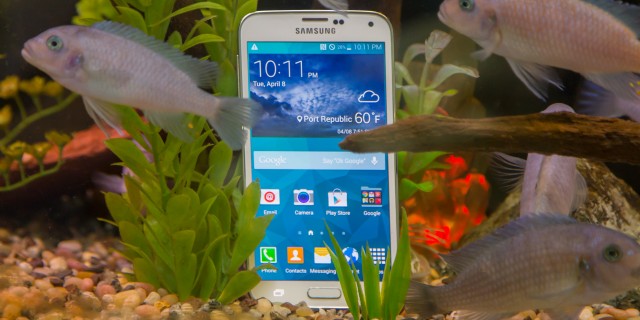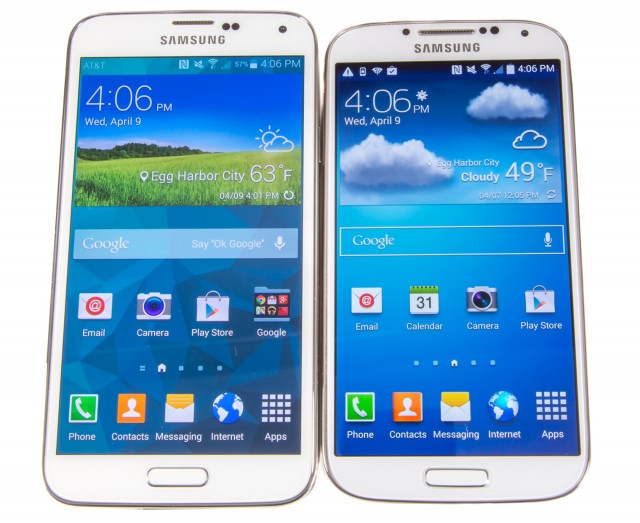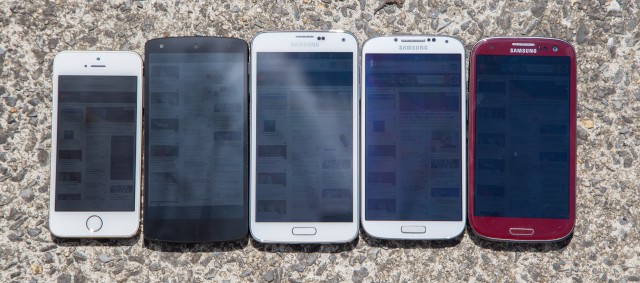
Samsung's newest flagship is finally here. With the Galaxy S5, Samsung hopes to break out of the boring spec-bump-style upgrade that the company said hindered sales of the Galaxy S4. While the design is mostly the same (and we might say a little worse), Samsung's solution to consumer indifference is a boatload of extra features. With the S5, Samsung added things like a fingerprint scanner, a heart rate monitor, and water resistance.
A spec bump also happened of course—just about every number on the spec sheet is bigger than it was last year. The S5 has a faster Snapdragon 801 processor, a better camera, better Wi-Fi, and a display that is both brighter in sunlight and dimmer in darkness.
Video Review
Design
The Galaxy S5 is actually a little bigger than the S4. It's 5.4mm taller, 2.7mm wider, and 0.2mm thicker. Samsung used this extra space to bump the display up to a 5.1-inch, 1080p AMOLED, slightly larger than the 4.99-inch display in the S4. The screen size increase didn't keep pace with the bigger body though. In a world where bezels are constantly shrinking and OEMs like LG are touting the screen-to-bezel ratio on their devices, Samsung took a step backward. The company made the side bezels thicker and the top and bottom of the device taller. If the image above wasn't labeled, you would think the S4 (the one on the right) was the newer device.

| Specs at a glance: Samsung Galaxy S5 | |
|---|---|
| Screen | 1920×1080 5.1"(432 ppi) AMOLED |
| OS | Android KitKat 4.4.2 with Touchwiz |
| CPU | 2.5GHz quad-core Snapdragon 801 |
| RAM | 2GB |
| GPU | Adreno 330 |
| Storage | 16GB or 32GB, with MicroSD slot |
| Networking | Dual Band 802.11b/g/n/ac, Bluetooth 4.0, GPS |
| Ports | Micro USB 3.0, headphones |
| Camera | 16MP rear camera with Phase Detection AF, 2MP front camera, |
| Size | 142.0mm x 72.5mm x 8.1mm |
| Weight | 145g |
| Battery | 2800 mAh |
| Starting price | $200 on contract, $649 unlocked |
| Other perks | RBG notification LED, IrLED, NFC |
Other than the bloated bezels, the design is very similar to the Galaxy S4. The corners are a little less round, so along with the bigger size, the device creeps slightly closer in appearance to the Note 3. The fronts of Samsung's entire product line seem to vary only in screen size and corner roundness. Though it's worth noting the button layout has changed—Samsung finally killed the menu button and now uses the trio of "Recent," "Home," and "Back," with home being a physical button and the other two being capacitive. Being able to quickly hit Recent Apps is a big improvement over the increasingly useless dedicated menu button, which was deprecated in stock Android all the way back in version 3.0. The only downside is that the button layout is backward when compared to everything else—usually the positions of "Recent" and "Back" are swapped.
The 1080p AMOLED is technically not up to par with the very best LCDs out there. It still uses the Samsung "Diamond Pixel" layout, which only has two subpixels per pixel, instead of the usual three per pixel that you would get in a full-matrix LCD. On the Note 3, it was possible to see diamond-shaped artifacts in certain colors, but with the higher pixel density of the S5, this display looks just as good as any other 1080p panel to the naked eye. The S5 display has a feature called "Adapt Display" which claims to analyze "incoming lights and the contents you're viewing and automatically optimizes the color range, saturation, and sharpness of your display" in certain applications. We tried to observe this happening with a variety of different light sources localized over the sensor cluster (warm light, cool light, darkness, then eventually just blue and yellow light) and were never able to observe a change in color. If something is happening, it's very subtle.

Samsung is doing its best to improve the shortcomings of AMOLED. One of AMOLED's weaknesses has always been brightness, which meant the display had trouble standing up to direct sunlight. Samsung boosted the brightness output quite a bit, to the point where it's now up to the level of a good LCD. We'd say it's currently "moderately useable" in direct sunlight. (No phone can really stand up to the power of the sun, though, as the above picture shows.) One weird quirk of Samsung's brightness implementation is that "max brightness" on the slider isn't really max brightness. You have to set the GS5 to "auto" and put it in sunlight to get to the highest setting.
Besides being brighter, the display can also get dimmer. In a dark room, the S5 dims more than any other phone we've seen. This makes using the device in a dark room much more pleasant. We still feel like it could go darker though—in a totally dark room, it still gives off enough light to disturb the person next to you. This phone can be used as a close-range flashlight.
The fingerprint sensor

One addition to the front of the device that you won't be able to see is the new fingerprint sensor, which has been stealthily incorporated into the home button. Like the iPhone 5s, the Galaxy S5 fingerprint reader can be used to unlock the device. Samsung's fingerprint reader is a swipe-style reader, similar to what is available on many Windows laptops. Your finger must touch the bottom part of the touch screen and the home button at the same time, then swipe downward. To show just how much of a finger needs to be used, Samsung displays a silhouette on the screen (see above). Requiring a motion like this makes it almost impossible to use one-handed.
Samsung keeps up with Apple on paper here, but its implementation is far inferior to what's on the iPhone. The iPhone sensor works with only a press of a fingertip from any angle, making it easy to use with one hand. The mandatory two-hand-usage makes the fingerprint reader a real drag to use as a screen lock. One of the things the iPhone sensor really got right was how quickly and easily it could be used. Pressing the home button on the iPhone would wake the screen, and leaving your finger on the button would read your fingerprint and unlock the device. That whole wake/scan/unlock process takes only a second or two. By contrast, Samsung's reader requires two empty hands and a swipe motion. It's slow and inconvenient.
That said, what is here works just fine. We have a near 100 percent acceptance rate from the reader, and it deals with different swipe speeds just fine. What it does not deal with at all is angles—your finger has to swipe straight down. Luckily, the silhouette guide makes this obvious.
One area the Galaxy S5 has a big advantage over the iPhone 5s is that the S5 fingerprint reader is open to apps through Samsung's Pass API. PayPal already supports the fingerprint scanner, and with the FIDO Alliance touting this as the "first FIDO authentication deployment," support from other companies shouldn't be far behind.
Since you can replace your PayPal password with this and basically give the fingerprint scanner direct access to your bank account, security needs to be rock solid. According to a device teardown by Chipworks, the fingerprint scanner is made by Synaptics, the same company that makes most of the laptop fingerprint scanners out there (so at least an experienced biometrics vendor is behind the hardware). Still, connecting a largely unproven fingerprint scanner to a bank account is a scary proposition. Apple's fingerprint scanner was hacked pretty easily, but perhaps the larger scan area Samsung is using will end up being more secure. Only time (and hackers) will reveal if Samsung's fingerprint security is up to the hefty task of protecting a PayPal account.
reader comments
327